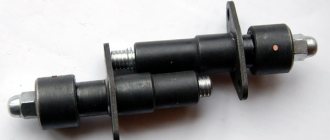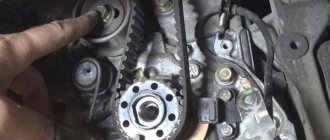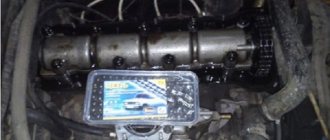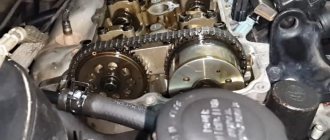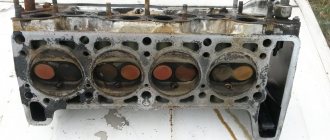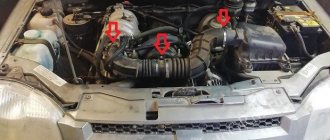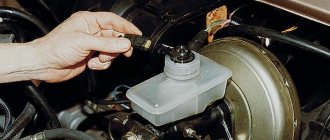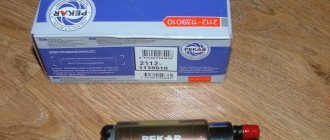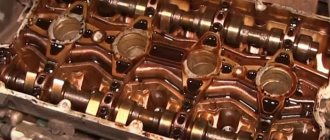“I have a chain motor!” - car owners often say with pride about their car, implying the exceptional reliability of such a unit and the absence of technical problems with the “eternal” chain. In fact, the chain drive of the gas distribution mechanism has both its advantages and a number of disadvantages. And with the current level of development of timing belt production technologies, it is not yet known which drive will be more reliable. Together with the specialists from the Stagecoach service station, we went through all the stages of replacing the timing chain on a 2.0 TFSI and found out a lot of interesting things.
When to change?
The main signs of wear on the part will help you figure out when to change the timing chain of the Kia Rio 3:
- the engine idles unevenly and roughly (the timing phases have changed);
- you can hear rustling and chirping (always at low speeds due to low pressure in the internal combustion engine lubrication system);
- the maximum power of the tensioner is visually determined, the condition of the gears is unsatisfactory (the teeth are worn out);
- When the tester checks the phase sensor, the error result is displayed.
What do you need to know about the Kia Rio 3 timing chain? The resource of the party responsible for the operation of the timing mechanism can reach 300,000 km. The condition of the circuit requires regular monitoring, and extraneous noise from the internal combustion engine should raise suspicions. The manufacturer notes that the unit may make noise when operating in cold conditions; After heating the noise disappears.
It is important to follow the maintenance schedule and change the engine oil on time. This will ensure normal lubricant pressure, on which the correct operation of the chain tensioner depends. When replacing, it is best to use original consumables (or proven analogues). Along with the chain, it is necessary to change the sprockets, guides, and tensioner, since these parts also wear out when using the Kia Rio 3.
When is it time to change your engine chain drive?
During everyday use of the car, the chain mechanism is subjected to the most stress and wears out. Therefore, it is important to know when it fails in order to make a replacement in time.
Each timing chain has a certain service life, during which, according to general rules, replacement is not necessary. However, there are cases when the chain drive (CD) suddenly breaks or some of the links become unusable, causing unstable operation of the entire engine.
In order not to miss this moment, it is recommended to periodically check the CPU for mechanical damage, and always before long trips over long distances, and replace it strictly according to the technical data and recommendations of the car manufacturer.
At the same time, it is worth noting that experienced car enthusiasts are able to detect a breakdown of the CPU mechanism by ear.
So, for a faulty CPU, the following sounds are characteristic when the engine is turned on:
- the appearance of a characteristic ringing noise in the area of the chain mechanism;
- periodic knocking and knocking sounds coming from the area where the CPU is located in the engine;
- shots and micro-explosions in the exhaust system and muffler.
If you need to check the performance of the CPU visually in order to accurately verify its (mal)functionality, then you need to open the engine.
How to check the condition of the circuit
There is a popular, very tempting and simple way, but it doesn’t work! The owners themselves tell me about this from time to time. The point is to reach the chain with your fingers and touch it to yield. The chain between the intake and exhaust gears will almost always be slack. Unfortunately, this is not so easy to verify.
A popular way to check the condition of the circuit
The condition can be assessed by the position of the chain tensioner, counting the number of teeth by which it has come out of the saddle.
7 teeth - need to be prepared, 8 teeth - time to change
The problem is that getting to the tensioner is not as easy as on other cars. Many engines have a special inspection window; there is no such window in Rio. Apparently, the plant is confident in the chain. To get to the turnbuckle you will need to remove the valve cover.
You can see how to remove the cover yourself in our video.
Your browser does not support
After removing the valve cover, many suggest checking the condition of the circuit for failure. But this method is not indicative.
At this stage, ignore any slack in the chain.
Let's see how advanced the tensioner is.
You need to find a place where you can see the chain tensioner. It is located on the left side of the engine, closest to the engine shield.
We count the number of teeth on which the tensioner came out
Consequences of a broken timing chain
A broken timing chain has become a real horror story for drivers. This is especially common for beginners. It's no secret that the timing belt, like most car parts, has a finite lifespan. After the timing life has been exhausted, it must be replaced.
As for the consequences of a broken timing chain, it all depends on the design of the power unit. When an engine is running, its pistons continuously move up or down from one dead center to another. During the fuel and air intake stroke, the piston moves to bottom dead center and opens the intake valve. When release occurs, the piston is already moving towards top dead center. And when he reaches it, all valves must be completely closed.
When the timing chain breaks, the camshaft stops rotating and the valves stop in the position in which the chain broke. The crankshaft in the engine continues to rotate, and the pistons are directed towards the open valves. Some engines provide the ability to avoid contact of the pistons with the valves through special recesses. In this case, the consequences will be limited to immobilization of the car. But there are situations much worse.
This is interesting: Punishment of a driver for not having a first aid kit in the car
Modern engines often have multiple valves. They were designed to develop maximum power, so piston recesses are not provided. When the pistons meet the valves, the latter bend and fail. You can avoid breaking all the valves at once if the timing chain breaks at idle. When driving at high speed, the entire set will need to be replaced after a break. At high speeds, the valve guides may also burst, which may even lead to the replacement of the cylinder block. Twin-shaft engines are generally more susceptible to such severe damage.
So, as a result of a broken timing chain, we have a domino effect. First, the valves are bent, then the camshaft along with the bearings is destroyed, then the cylinder head fails, and finally the connecting rods and pushers are bent.
Spare parts for changing the timing drive
To upgrade the timing unit on the Korean Kia Rio, you will need the following consumables:
Timing chain kit
- current KiaRio 3 timing chain (the original comes with article number 24321-2B200);
- tensioner (catalog number of the original part 24410-2B700);
- pump DOLZ (number H226);
- pump housing gasket (25124-2B000);
- guide strips - right (24420-2B000) and left (24431-2B000);
- cover gasket with spark plug well rings (22441-2B000);
- cylinder block o-ring (21142-2B000);
- front crankshaft oil seal (21421-2B020);
- Abro gasket sealant (13ABR).
Here is an extensive list, since the work of replacing the chain is labor intensive and allows you to update multiple worker nodes at the same time. If some parts are suitable for the car owner in terms of resources and degree of wear, they cannot be changed.
Replacing the Niva Chevrolet camshaft drive chain guide
The damper is located inside the front part of the cylinder head on the left and is attached to it from the outside with two bolts. If the damper is worn or damaged in some engine operating modes, resonant oscillations of the drive chain may occur, which can lead to the chain jumping on the teeth of the camshaft sprocket and causing serious damage
engine. You will need: a screwdriver, a wrench (preferably a socket) “10”.
Remove the camshaft drive chain tensioner (see “Replacing the camshaft drive chain tensioner”).
Using a chisel, bend the edge of the lock washer of the camshaft sprocket mounting bolt (for clarity, the hoses of the cooling jacket outlet pipe are disconnected).
Using a 17mm spanner, unscrew the camshaft sprocket mounting bolt.
Remove the bolt along with washers.
To loosen the chain tension, unscrew the nuts securing the hydraulic tensioner to the cylinder head
In this case, we do not open the tensioner hydraulic drive tube.
To prevent the chain from jumping, we tie it to the sprocket and remove the sprocket with the chain from the camshaft (see “Checking and setting the valve timing by marks”).
To prevent the chain from jumping, we tie it to the sprocket and remove the sprocket with the chain from the camshaft.
Using a 10mm spanner, unscrew the two bolts (of the same length) securing the chain guide to the cylinder head.
The bolt has a cylindrical shank for alignment in the damper hole
When removing the damper, hold it securely with your hand, otherwise the damper that has fallen into the oil pan will be very difficult to remove.
Inspect the removed damper.
If there is a deep groove from the chain and chips on its working surface, or there are cracks and breaks on the damper body, replace the damper.
Pay attention to the original shape of the damper - it differs from the dampers previously used on VAZ engines. Buy exactly the same sedative
Buy exactly the same sedative
Install the new damper in the reverse order of removal.
Install the previously removed parts in reverse order.
How long does a chain last?
It's amazing how many different myths and fairy tales you can learn about the chain:
- The chain is unreliable and stretches up to 100,000 (in fact, the original chain does not expand, but counterfeits and duplicates do).
- In Rio this is a weak point, you need to constantly check the chain tension. (It is not true).
- Easily torn. (Only if on a car before 2013, when accelerating until it turns off, a downshift is accidentally engaged. And this is not a fact).
- Easy to jump. (Isolated cases).
- The chain likes to shake. (No).
In practice, since 2012, ONLY more than one chain has broken, and with one skid - only a few cars.
By modern standards, the chain is eternal. I don’t remember any other machines with a similar resource. Today there are already many Rios with huge tracks and still with a home track. If in numbers, then up to 300 thousand km is not even worth thinking about. About 450 thousand km you can already try out the scheme. We focus on these numbers only if you are sure of the mileage. If the car is purchased, but you should not be guided by the odometer numbers. Today there are many cars with winding paths. Such a service on the market costs only 500 rubles. Twist, usually in the middle of the stroke. Therefore, it is necessary to check the condition of the circuit.
Possible faults
In the family of cars of the Volzhsky Automobile Plant, which are called “classics”, the timing drive is made in a chain version. The service life of a good double-row chain is longer than any belt, and the chain is better protected from any external influences while being inside the engine block. Instant stretching of the chain is excluded; moreover, the chain, unlike the belt, will not slip when the engine is suddenly revved up. The downside: noise and some cumbersomeness are not so noticeable when operating the VAZ-2107.
Tensioner diagram: 1 — camshaft sprocket; 2 - timing chain; 3 — chain damper; 4 — auxiliary drive sprocket; 5 — crankshaft sprocket; 6 — tensioner shoe; 7 — hydraulic chain tensioner; 8 - oil line fitting
Unfortunately, the chain also does not last forever. It also stretches - only not immediately, but gradually, as a result of the metal fingers working against the gear teeth.
Signs that the chain has stretched and you need to diagnose the degree of its serviceability are the following:
If the chain has only slightly stretched, you can compensate for the sag by increasing the pressure with the tensioner shoe. When the limit of adjustments has been exhausted, only replacing the chain can help.
Chain stretch even of a few millimeters is noticeable to the eye
In order to better understand when you can get by with little blood and when to change the chain, the manufacturer has established the approximate resource for normal operation of the timing drive, which on the “seven” is 60 thousand kilometers. When used beyond the specified period, there is a risk of not just stretching, but the teeth jumping during operation, or the unit breaking.
Jumping the chain by one or two gear teeth leads to a violation of the valve timing, which will affect malfunctions even at idle speed, not to mention operation under load.
An open circuit leads to the disappearance of synchronization between the revolutions of the crankshaft and camshaft. As a result, the pistons, by inertia, hit the valves open inside the cylinder, deform themselves and deform them. The pistons of the “seven” engine have special grooves that protect the valves from bending. But if the engine has undergone a major overhaul with the replacement of the cylinder-piston group, the pistons may well not have recesses, then the risk of serious damage increases. Monitor the drive chain and change it on time.
How often do you need to change the timing chain on a Kia: opinions of car owners
- They offered to navigate the sound “My Kia Cerato has traveled 157,000 km. I contacted the dealers and clarified when it was necessary to change the sales chain. They answered that it is different for everyone and regardless of mileage. Someone needed a replacement after 70,000 km, and someone came with a mileage of 250,000. Experienced Kia owners told me that I should be guided by the sound - they say, when the chain rings, they plan to replace it.”
- You should change it regularly “I have a Kia Sorento, I was once thinking about replacing the timing chain. I asked the salespeople when to switch. They didn’t give me a firm answer, saying that they usually come for a repair kit to repair the engine after a chain drive breaks down. In general, it all comes down to what needs to be changed after a breakdown. This is sad because a major engine overhaul will cost a pretty penny. As far as I understand, I decided: the chain needs to be changed regularly, at least every 200,000 km.”
After replacing the timing chain or belt, the engine does not start: main causes and troubleshooting
Before starting diagnostics of the timing drive, it is recommended to immediately check the proper operation of the ignition system, the condition of the battery, the correct connection of power system elements, electronic ECM sensors, etc. If no malfunctions are identified, then we move on to the gas distribution mechanism drive.
In the list of the main reasons why the car does not start after replacing the timing belt or problems appeared after the chain drive was changed, experts identify possible damage to the valve mechanism and misaligned valve timing as a result of improper installation.
Similar faults can occur on different car models.
First of all, it is important to know that errors when replacing the timing drive can lead not only to failures, but also to subsequent breakdowns. You also need to separately take into account the reason why you had to change the drive elements
The engine does not start: the valve is bent
For example, if the timing belt breaks, then the belt is changed and the car does not start, then bending of the valves after such a break should not be ruled out. The fact is that at the moment the belt breaks, the valve timing on many engines is disrupted, the camshaft does not rotate, and the timing belt stops working. This means that the valves no longer open and close in a timely manner.
However, the pistons in the cylinders still continue to move. It often happens that the valves remain open, causing the pistons to hit them. In this case, the valves become bent, and the pistons can also be damaged. At the same time, replacing the timing belt alone cannot solve this problem, since the engine requires separate expensive repairs.
Note that previously, internal combustion engine manufacturers took into account the risk of bending and machined special recesses for the valves on the piston surface. At the same time, the presence of such grooves reduces engine power, as a result of which such a solution was abandoned on modern engines.
The valves can be checked in the field by removing the valve covers, after which the engine is cranked by hand and the operation of the mechanism is assessed. If it is noticed that any valve is not working, then it is bent. Please note that such a check is just a superficial diagnosis, since even with bent valves the mechanism will often visually work normally.
For this reason, to accurately assess the condition of the valves, it is preferable to remove the cylinder head. Once removed, bent valves can be quickly identified and the procedure for replacing them can begin immediately.
Please note that it is recommended to replace all valves immediately with new ones, and not replace only bent ones. Also, during the installation process, it is necessary to grind in the valves.
Timing belt replacement performed incorrectly
Unqualified replacement of the timing drive often leads to the fact that after replacing the timing chain, the engine does not start well, a belt-driven motor does not start, etc. The problem is that the timing belt may not be aligned and the phases may not match.
The result is that the operation of the gas distribution mechanism and the ignition system is not synchronized, the mixture is compressed in one cylinder, and a spark is formed in the other.
For these reasons, an important point is the exact match of the marks on the pulleys
During the replacement process, special attention should be paid to the position of the marks. The engine is set to the end position of the compression stroke in the first cylinder, after which the position of the marks is checked
If a deviation is noticed, then this is the reason the engine refuses to start. In such a situation, the timing belt must be removed and the camshaft pulley must be correctly aligned taking into account the marks. Let us add that many car models also have a special mark on the flywheel, which must also match.
It should be noted that the flywheel is usually dirty. In many cases, this makes the tag difficult to detect. As practice shows, on the flywheel, in addition to the mark that needs to be set, there may also be characteristic indentations-pits. If you mistakenly replace the mark with the edge of the hole, which is visually similar to the mark, then the engine will not start.
Also, during the process of replacing the timing drive on cars with a carburetor, the ignition may go wrong. Quite often, a violation of the spark supply to the cylinders can be determined by installing the spark plug armor wire of the first cylinder to the fourth, and the wires from the fourth cylinder to the first. In some cases, after such a rearrangement, the engine can be started.
If such a failure is detected, then the gas distribution mechanism drive must be set correctly, and if necessary, additional adjustments and adjustments to the ignition system are also made.
What is the cost of replacing a Kia timing chain?
To perform such a responsible and complex operation requires high qualifications, experience and the availability of professional tools. Even though the chain is made of metal, it will wear out over time and require replacement. Due to its placement inside the Kia engine, routine driving diagnostics always involve disassembling the engine using special tools. Due to the usual weakening of the tensioner, the load on the transmission links increases and the connecting elements wear out significantly. Eventually the drive stops, causing damage to the pistons and valves.
Not a single car owner wants to deal with repairs, much less engine replacement. If we talk about replacing the timing chain on a Kia, the price of this operation will later pay off. At the same time, all worn-out transmission parts are updated: bearings, oil seals, tensioner, etc., which ensures the longest possible service life of the unit.
Replacement costs will vary depending on the make of the vehicle. In particular, for Kia this procedure now costs from 8,000 rubles in Moscow, excluding consumables and spare parts. In the provinces, prices are often lower.
If the work is carried out by professionals, then there will be no problems with the operation of the Kia engine and repeated malfunctions will be excluded.
Timing chain life
The timing chain resource is not at all infinite and has a very specific time frame. It has been established that the average service life of a timing chain ranges from two hundred to four hundred thousand vehicle kilometers. The numbers greatly depend on the driving style of the car. If your driving style is aggressive or the car is often driven on poor road surfaces, the service life may be significantly reduced. It has also been established that double-row chains of new Japanese and German cars are capable of maintaining strength for 400 - 500 thousand kilometers.
Detailed description of replacing the timing drive
Replacing the Kia Rio 3 timing chain involves using the following tools:
- keys (14, 17, 19 and 22);
- taken (14, 17 and 19);
- flat head screwdrivers;
- extension;
- crank.
- The procedure for replacing parts of the main operating units of the Kia Rio 3, which are responsible for gas distribution, will be presented below.
Removing the cylinder head cover (and installing it during assembly)
Replacing the Kia Rio 3 chain involves removing the cylinder head cover. First, the ignition coils are removed. There are four of them on the car. First, unscrew the bolts securing the spark plug well cover. Each coil is secured with a bolt that needs to be loosened. The parts are removed one by one from the wells, the blocks with wiring are disconnected from them, then we remove the two pipes responsible for ventilation of the engine crankcase (fastened with clamps with lugs).
Removing the cylinder block cover
The cylinder head cover is screwed on with sixteen bolts, which must be unscrewed strictly according to the diagram. When tightening bolts after assembly, the tightening torque must be observed. For the first pass it should be equal to 3.9-5.9 N * m, for the second - 7.8-9.8 N * m.
When disassembling the cover, it is necessary to remove the gasket from its grooves, and also remove the gasket from the spark plug wells. Dry the remaining oil, install new seals in place of the old ones and carry out final assembly (after replacing worn-out parts).
Setting the first piston to top dead center
The piston of the first cylinder must reach the TDC (top dead center) position so that the valve timing is not disturbed later.
Putting shortcuts
TDC is set according to the marks on the camshaft sprockets. The mark on the crankshaft pulley should coincide with the “0” mark on the protrusion of the cover behind which the chain is located. Otherwise the engine will not work properly. You also need to focus on the location of the serrations on the sprockets (they should be flush with the surface of the cylinder head and opposite each other). The Kia Rio 3 chain, if it is installed incorrectly after replacement, must be removed and the crankshaft turned to the desired position.
Drain the oil and remove the right support bracket
On Kia Rio 3 cars, the timing belt and its parts are changed when the oil is drained and the right engine mount bracket is removed. A container is required to drain the contents of the lubrication system.
Drain the oil
First, unscrew the oil filler cap, then (after preliminary cleaning with a brush and rag) unscrew and completely unscrew the drain plug in the oil pan. The oil will be hot, so precautions must be taken.
Disassembling the bracket is carried out as follows:
- A support is placed under the crankcase (through a wooden plate).
- The mounting bolt and two nuts on the studs are unscrewed.
- The nut holding the bracket in the holder is loose. The part has been removed.
Remove the attachment belt and tensioner
The Kia Rio 3 belt is necessary for the operation of additional equipment (for example, a generator). The belt can be easily removed; to do this, just lift the car, remove the right wheel and turn the tensioner pulley counterclockwise with a wrench. A loose belt can be easily removed from the tensioner pulley. Signs of wear, oil and cracks indicate the need to replace the belt.
The next step is to release the power steering pump (unscrew the top bolt) and move it to the side. Then the belt tensioner mounting bolt (has a reverse thread) is unscrewed. The fastenings of the lower bracket of the right support are also unscrewed. The part has been removed. The intermediate roller is released. The procedure is necessary to get to the cover behind which the Kia Rio 3 distribution network is located.
Dismantling the pump
Replacing the timing chain on a Kia Rio 3 involves removing the water pump. To disassemble, you need to unscrew the fasteners that prevent rotation of the pump pulley. The pump is attached to the power unit with five bolts. They are turned upside down, the body is pushed out and removed from the seat.
Disassemble the pump
The old gasket must be removed and replaced.
Removing the crankshaft pulley and generator
The next step when replacing the timing belt on a Kia Rio 3 is to remove the crankshaft pulley and disassemble the generator. The pulley must be held with a special device. It is fixed in the center with a bolt.
Crankshaft pulley
As for the generator, work must be done with the wire disconnected from the negative terminal. At the first stage, the wiring blocking is disabled. Then the protective cap is removed and the power cord is released. The lower and upper bolts securing the generator are unscrewed. The device has been completely removed.
Replacing the crankshaft oil seal
The crankshaft oil seal is installed in a cover behind which the chain is hidden. It will need to be replaced. You can remove the part with a flat screwdriver. But if this does not work, screws are screwed into the cage and the Kia Rio 3 crankshaft oil seal is pulled out with pliers.
Crankshaft oil seal
The new oil seal is lubricated with oil (the working edge entering the engine is processed). Crimping is done with a suitable mandrel (you can use a head from the kit) using a hammer.
Removing the timing cover and timing chain of Kia Rio 3
The cover is secured with fourteen bolts that must be unscrewed. The Kia Rio 3 timing chain tensioner has a shoe that is retracted and secured with a pin. The tensioner fastener is unscrewed and the part is removed to the side. The exhaust camshaft is turned clockwise so that the chain can be removed from the sprockets. Replacing a chain involves installing a new part according to the instructions.
Sources
- https://autonissancar.ru/kia/rio/rio-3/menyaem-tsep-grm-kia-rio-3
- https://g-light-auto.ru/shhetki-stekloochistitelya/remen-ili-tsep-grm-kia-rio-3-zamena.html
- https://artikul-cars.ru/kia/rio-3-sedan-2011-2015/engine/cep
- https://www.autoservice-korean.ru/inf/rio/zamena-remna-grm/
- https://kiarioinfo.ru/ekspluataciya/zamenit-remen-ili-cep-grm.html
- https://rad-star.ru/pressroom/articles/zamena-tsepi-na-grm/
- https://razborov.net/kia/kogda-menyat-cep-grm-kia-rio-3.html
Signs of a timing belt malfunction
External signs of timing belt malfunction and their causes are presented below:
- A metallic knock is heard in the cylinder head at low and medium engine speeds. Engine power decreases. Such malfunctions arise due to a violation of the thermal clearance of the valves and wear of the bearings and “cams” of the shaft, which serves as a distributor.
- A metallic knock in the cylinder head comes from a cold engine. Engine power is also reduced. This occurs due to a malfunction of the hydraulic compensators.
- Noise is heard in the camshaft drive area. Popping sounds are heard from the muffler. Look for the cause either in wear of the drive chain or in wear of the drive toothed pulley.
- The exhaust gases released have an uncharacteristic blue tint. The oil level in the engine crankcase is reduced. Engine power is reduced. This occurs due to wear of oil seals, valve stems and guide bushings. The reason may also lie in damage to the crank mechanism.
- Ringing metallic sounds are heard when the car accelerates. The engine runs intermittently. This occurs due to the formation and deposition of carbon deposits on the valves, malfunction of the crank mechanism and the use of fuel of questionable quality.
- Short-term dips occur in the operation of a cold engine. Engine power decreases. The engine overheats very quickly and severely. The reason is a decrease in elasticity, breakage and hanging of valves.
The most serious timing fault is stuck valves. This often leads to breakdown of the entire engine. Fortunately, this malfunction in modern cars is taken into account and is quite rare.
Malfunctions of hydraulic compensators deserve a separate topic. If you use too thin or dirty thick oil, the hydraulic compensator stops eliminating gaps in the timing belt. This leads to jamming of the hydraulic compensators.
Violation of the thermal clearance on engines with adjustable clearance can occur not only due to bearing wear, but also due to incorrect clearance adjustment.
Diagnosing timing belt faults is difficult due to the similarity of their symptoms. Diagnostics is most often carried out by removing the cylinder head cover and inspecting the structural elements.
Schedule and frequency of work
The timing chain, like any other car part, has its own working life. Its duration is affected by operating conditions, the model and brand of the machine and the type of motor. On average, the life of a chain is 60 thousand kilometers or two years, but you should not delay too much with changing parts. There is also no need to wait until it wears out to such an extent that it begins to fall apart. Many modern vehicle models have integrated sensors that notify the driver when a given part is due to be replaced.
The timing chain also has its own service life. After 100 thousand kilometers, it stretches out and sags. The reason for this is wear of the hinge joints and an increase in the distance between them. As a result, despite normal compression, adjusted valves and serviceable ignition and power systems, the power unit operates intermittently at idle. The chain jumps one or two teeth. This can provoke either a simple stop of the power unit, or jamming of the valves and a major overhaul of the engine.
How to determine wear
As already noted, the chain is subjected to serious loads during operation. As a result, the part stretches over time and the link connections wear out. Sooner or later, such a part may jump one or more teeth. Depending on the engine, this situation can be quite dire. To avoid unpleasant consequences, you need to replace the chain in accordance with the recommendations of the manufacturer of your car. Experts have different opinions about the fact that it is possible to determine the wear of a part by sound. Some believe this is impossible, others are of the opinion that the condition can be determined by the following signs:
- A characteristic ringing noise appears in the timing drive area. It may also be accompanied by small shocks. Gradually, the ringing may intensify, which will lead to shocks.
- When the chain is stretched, the valve timing shifts. As a result, fuel injection will be early or late. This causes unburned fuel in the muffler to ignite. If there are shots in the exhaust system, one can judge that the timing system and, in particular, the chain are faulty.
The part in question has a certain resource. Depending on the engine and operating conditions, it can range from 30–160 thousand km. Even taking into account the manufacturer’s recommendations and observing the replacement deadlines, the actual figures may differ. The car can be used in a wide variety of conditions and sometimes quite difficult ones. The manufacturer tests its cars at a testing ground, and daily use in city traffic jams has a much greater impact on engine wear. Weather conditions also affect the timing of replacement parts. Despite the fact that the timing belt and chain perform the same function and the chain lasts much longer, you should not forget about its timely replacement.
With high mileage of the car, the timing chain stretches and if appropriate measures are not taken to replace the part, then in the future the engine may require serious repairs
What can cause damage to the timing chain?
Today there are many power units, both modern and old brands, in which the arrangement of valves and pistons is made in one block. During the operation of the pistons in the cylinder, fuel and air move. In simple words, at the moment when the piston is in the upper position, the valves are closed. At this moment, the fuel-air mixture ignites. When the piston is in the down position, the valves open to release exhaust gases and admit fuel. Thus, the entire mechanism operates correctly, and most importantly, synchronously.
If a break occurs, then this synchronicity is disrupted. As a result, the piston hits the valve, the valve bends, and the piston may be damaged. The engine will not be able to operate as before and will require serious and sometimes expensive repairs. There are times when you can get by with low costs. But not only chain breakage is important, but also its stretching, which was already noted above.
If the timing chain is too stretched, engine parts can be damaged. The photo shows damaged valves as a result of an impact on the pistons
When is it time to change
Some manufacturers assure that the part does not need to be replaced during the entire service life of the car. This statement is appropriate for ideal operating conditions of the car. However, it is better to replace the part every 100 thousand km. mileage If you hear a metallic ringing or knocking sound when the engine is running, then most likely the chain is stretched and it is slipping. With such symptoms, replacement should be urgent. The need for replacement can be judged by thick bluish exhaust, a drop in engine power, loud sounds in the muffler, and a sharp increase in engine temperature for no apparent reason. In most cases, these signs appear together and indicate wear of a given part.
If you purchased a used car, then you definitely need to pay attention to the timing chain. Even if the former owner said that he had recently replaced it. There are some cars that have a special indicator on the instrument panel that signals in case of problems with the gas distribution mechanism. If the chain is not replaced in a timely manner, it will slip, causing damage to the block head. At best, this will lead to bent valves; at worst, the cylinder block will have to be replaced, as it will simply become unusable.
How to choose the right new spare part
So, we found out when the engine needs to replace the part in question. But how to choose it correctly, because the chain can be either single-row or double-row. Each option has its own pros and cons:
- The single-row chain provides a slight increase in engine power and helps reduce noise. This is due to the fact that it is easier for the engine to rotate one row than two.
- Despite the fact that the double-row chain is noisier, it is endowed with greater reliability. It is characterized by a longer service life.
In addition, chains have different numbers of links. Depending on the make of the car and the type of motor, different chain options may be used. If we consider cars such as the VAZ 2101 and 2102 with a 1.2 and 1.3 liter power unit installed on them, then they are equipped with a part for 114 links. For cars with power units of 1.5, 1.6 and 1.7 liters, a 116-link chain is used, respectively. This applies to the VAZ 2103, 2107 and 21213 models. When replacing the chain, it is necessary to clarify the information in the corresponding document for the car.
For timing chains, chains can be single-row or double-row. This or that chain is selected depending on the car model and engine type
Replacing the chain tensioner in Toyota through the eyes and hands of car enthusiasts
- Replacing the tensioner is not a panacea “I wondered how the chain should behave after replacing the tensioner? The other day I made a replacement on my Toyota, and strange sounds appeared when I pressed the accelerator pedal. Then the noise disappeared, but I'm wondering if everything is okay? A friend says there will be problems with the timing belt. After all, if the chain is stretched, the new tensioner will quickly fail.”
- Changing the tensioner yourself is scary
“I picked up a tensioner for Toyota today.” But I'm afraid to replace it myself. I've read reviews from car owners who change them themselves. Often, after such intervention, even more problems appear. I studied the instructions on how to make the replacement, everything is shown there, how to and how not to change, but I didn’t see the difference.” - There's nothing scary
Replacing the tensioner in a Toyota with your own hands is easy; even a beginner can do it. Personally, I installed the tensioner on the hook and applied sealant to the gasket. I installed the part, tightened the bolts, took a 19mm socket and a ratchet. Then he rotated the crankshaft in the opposite direction to rotation. I heard a click - it was the tensioner that jumped out. Then he scrolled again, but this time in the direction of rotation. Everything is perfectly audible and understandable.”We recommend
“Replacing an automatic transmission in a Toyota Corolla: at a service center or on your own” Read more
- I replaced it, but nothing is clear
“I encountered the following problem when replacing the tensioner in a Toyota: I turn the crankshaft clockwise, but I don’t know how many turns I need to make. I clicked twice in 1 revolution; when I started the engine, there were 2-3 more clicks. That is, when the crankshaft rotates clockwise, it tensions the chain when starting the engine?When I started the car another time, nothing clicked. I turned the crankshaft - nothing. There are no noises, everything seems to be fine.”
Step-by-step instructions for replacing the timing belt yourself
Repairs begin by preparing the car for partial disassembly of the engine. To do this, the machine is placed on a pit or a lift. Remove the engine protection, drain the antifreeze from the radiator, dismantle the main radiator with cooling fans. Loosen the fastening of the power steering pump and generator, remove the drive belts.
With an air conditioner, there are 2 options: drain the refrigerant and dismantle the radiator, or carefully move it to the side and hang it so as not to break the hoses. We disconnect all the cooling system hoses that interfere with the repair area. Remove the air filter, throttle cable, air pipe. In this semi-disassembled form, you can proceed directly to replacing the timing chain.
Procedure for replacing the Niva Chevrolet chain:
Choosing a mechanism chain: what kits are there?
There are two main types of timing chains. Usually, when purchasing a new chain in car dealerships, they ask how many links it is needed for.
The first type is a 114-link chain, installed on engines with a displacement of 1.2 or 1.3 liters. Domestic cars are equipped with similar chains.
Timing chain 114 links
The second type is a chain with 116 links. It is installed on engines with a volume of 1.5, 1.6 and 1.7 liters. Such parts are used on domestic and foreign brands of cars.
Timing chain 116 links
Timing chain: how it works and how to change the chain
There are no more or less critical elements in the engine, but there is still a mechanism, the incorrect assembly of which can only be discovered after installation is completed and an attempt is made to start the engine. Yes, just an attempt - and often unsuccessful. “Jump” the master by one tooth or make a mistake in at least one mark - and hello, disassembly! It’s good if the timing belt drive is a belt drive - and if it’s a chain that is enclosed in a housing and covered with a lid... But first things first.
Why is a timing drive needed?
For those who came here to educate themselves, we will traditionally give a brief excursion into the structure and purpose of the gas distribution mechanism. In short, its role is to provide communication between the opening/closing of valves and the movement of the piston (and with it the crankshaft), for which it is necessary to connect the crankshaft to the camshaft. In terms of the gear ratio, the connection is rigid: it is always 2 to 1 - that is, for every two revolutions of the crankshaft there is one revolution of the camshaft.
In general, the timing drive ensures compliance with the valve timing. Does it sound scary? In reality, everything is not so scary, it’s enough to start with the basics. The engines we are considering are four-stroke, that is, during their operation four strokes are constantly performed: start - compression - power stroke - exhaust. Phases are the valve opening moments expressed in the angle of rotation of the crankshaft. Yes, that’s what they write: the opening angle of the intake valve is 12 degrees before TDC (top dead center, where the piston stops before going down). This means that the valve will begin to open thanks to the camshaft cam when the piston slightly reaches TDC. A little - these are the same 12 degrees of crankshaft rotation. Another 12 degrees clockwise and the piston is at TDC. Well, the phases are a schedule for the opening of valves.
If the engine is equipped with phase shifters (for example, the VANOS system from BMW), then the angles of these phases can change. But valve opening angles do not exist in isolation from the system: the fuel injection system and ignition system (if the engine is gasoline) operate depending on them. It turns out that if the master made a mistake when installing the timing drive, the valve will begin to open not at 12 degrees, but, for example, at 14, but the injection and ignition will work in the hope that everything is correct. Valves that are opened and closed at the wrong time will result in unstable engine operation, and if the “jump” turns out to be significant, then the meeting of the valve with the piston will not be far away.
Articles / Practice The evolution of the timing belt: gears, chain and belt Do you like to argue on the automotive topic and argue which is better - a belt or a chain? Nothing makes a debater more important than knowing the history of the development of mechanisms! We will tell you how... 87370 3 15 12/26/2014
What types of drives are there?
There are several ways to connect the crankshaft to the camshaft: belt, chain, gear and combined (this is exactly our case). In general, from their descriptions everything is already clear - at least with the first three. In the latter case, gear and chain types are often combined.
Each type of drive has its own advantages and disadvantages. The belt is easy to maintain and relatively inexpensive, the chain is more reliable than the belt, but requires lubrication, the gears are almost perfect, but their weight and installation during assembly are a living hell. They combine different types if it is necessary to achieve the required result for less money.
What can go wrong?
Of course, for different types of timing drives, possible malfunctions and breakdowns also differ. Let's look at them all in order - and start with the belt. The very first and main problem here is the wear of the belt itself, expressed in its fraying and stretching. Belt teeth can also be sheared. Well, the second “weak link”, of course, is the tensioner and intermediate rollers. They, like the belt, wear out and therefore often require replacement along with the belt. At the same time, when replacing the belt, the wear of the teeth on the toothed pulleys of the camshaft drive is also checked.
If the timing belt is driven by a chain, then there are two main types of problems: either the chain is stretched, or the teeth of the sprockets are worn out, or both occur. The most common option is the first. If the chain is replaced, the tensioner shoe and damper are replaced along with it. These two parts are necessary to align the operation of the chain. After all, the belt is elastic in itself and stretches due to its own elasticity. The chain is devoid of such properties - and therefore, so that during operation and changes in speed the chain links do not bite, a damper is installed, which is a metal plate with a plastic working part, against which (of course, not without lubrication) the chain “rubs”. Well, for constant tension of the chain, a tensioner and a shoe are installed, similar to a damper, but fixed only on one side (to be able to move it).
The chain is metal and therefore requires constant lubrication. Because of this, it is located in the housing and covered with a metal lid. In some cases (as in ours), to improve its lubrication, an oil sprayer is additionally installed, aimed directly at the chain.
If we talk about maintainability - that is, the ease of replacing the chain, then everything depends on the manufacturer. For example, Mercedes “loves” to replace the chain without removing the cover - moreover, they indicate this as the main replacement method. This method has been known since the appearance of the chain and consists of the following: using a special device, the chain is opened - the axle is pulled out from one link. It turns out there are two ends, to one of which a link of the new chain is connected, after which the crankshaft is turned and the new chain is “driven” in a circle, while at the same time pulling out the old chain. Then all that remains is to connect the links of the new chain with an axle. It seems to be nothing complicated - but only in theory. In fact, the probability of “jumping a tooth” with this method is the highest.
The regulated service life of the chain also completely depends on the manufacturer: someone says that after 150 thousand kilometers it is time to change it, and someone (Honda, for example) declares its service life “for the entire service life of the engine.” It happens that to improve performance, the drive is divided into two circuits (Hyundai loves this). In this case, replacement will have to be performed exclusively by removing the front cover.
Articles / Practice Timing chain or timing belt - which is better? Perhaps this question is one of the ten most philosophical questions in the automotive industry, along with right-hand drive and left-hand drive, diesel and gasoline, manual and automatic. Finally, we will decompose the d... 228610 26 20 12/30/2014
The timing gear drive is the oldest. Of the obvious advantages, it is worth mentioning that it is free from such diseases as a belt or chain. Nothing in the gears stretches or delaminates, the teeth do not jump, a tensioner is not needed... True, in this case it is necessary to closely monitor the quality of the engine oil - but this is not the most important thing. The main difficulty of the gear drive is that if for some reason it had to be disassembled, then putting it back together while maintaining all the marks will be quite problematic. Moreover, there are engines (for example, 2.5 TDI from Volkswagen) for which it is impossible to assemble the timing drive or check the correct valve timing without a set of special tools! They simply don't have the appropriate markings on the gears. So if you have an engine from this particular concern, and it has a gear drive, then before asking for help from a mechanic, make sure that the latter has a set of special devices - otherwise you will simply get stuck at the station.
Combined drive: it was already indicated above that these are often gears plus a chain. Our “patient” has exactly this scheme. Here, the crankshaft gear drives: the camshaft drive gear, the oil pump, the right and left balancer shafts, the high-pressure fuel pump, the vacuum pump and the power steering pump. However, in order not to add even more bulk, the designers decided that it would be better to connect the camshafts via a chain - then there would be no need to install additional intermediate gears and complicate the life of repairmen. In addition, if necessary, the chain can be replaced in the old-fashioned way that Mercedes-Benz loves. Fortunately, Mitsubishi decided not to disturb the imagination of the craftsmen and carefully marked the relative positions of the gears relative to each other (this will be clearly visible below).
What is good about the described type of drive? The fact is that to transmit rotation to such a quantity of equipment one would have to have a chain several meters long or install several chains (some, however, do this), and this would significantly increase the cost in case of repairs. In addition, gears are still more reliable, and only specific elements can fail, for example, an oil pump or a vacuum pump, and the drive gears themselves only in exceptional cases. As for problems with the chain, replacing it will not be difficult.
What is checked during a major overhaul?
Articles / Practice Overhaul of a Mitsubishi turbodiesel with a mileage of 500 thousand kilometers: cylinder head No one can avoid this. Sooner or later He will knock on your... cylinder head or cylinder block. It is a major engine overhaul. The times of “millionaires” have long since sunk into oblivion, and large-scale... 12755 0 1 09/28/2016
With the belt, everything is very clear: due to its relative simplicity and low cost, the matter is limited to replacing all the parts - the belt and rollers. If the timing drive is chain driven, first measure the length of the chain - sometimes factory manuals provide data on the diameter of the chain wrapped around the sprocket. The sprockets themselves are checked for chips and tooth wear: these parameters are enough to understand whether the chain requires replacement.
If the timing belt is driven by gears, then during repairs the technicians measure the gap in their engagement. Two gears are placed on the shafts, one of them is blocked, an indicator is installed on one tooth of the second and, moving it, the gap is measured. If the wear is excessive, the gears must be replaced, both of them. The teeth are also visually checked for wear and chips: if everything is in order, the gear returns to its place. The combined type of timing drive does not need description - it combines the diagnostics of the types included in it.
Working with the timing drive of Mitsubishi Pajero Wagon
We described the entire biography and characteristics of the engine and model of this specimen in the previous article - let me just remind you that it is 550 thousand kilometers old, and it was “fed” with exceptionally good oil. Having disassembled the engine and dealt with the cylinder head, we proceeded to the timing drive.
When disassembling the mechanism, there were no particularly interesting procedures that deserve description, since there are practically no such crucial moments as with the block head, such as unscrewing the bolts in a certain sequence. The most important thing when disassembling is simply not to lose anything. But for the sake of clarity of information, I will still clarify that the thermostat, water pump (pump), crankshaft pulley, air conditioning compressor and generator had to be dismantled. The rest, as mentioned above, is driven by gears.
1 / 3
2 / 3
3 / 3
Having finished with the above, we unscrewed the mounting bolts and removed the vacuum pump, followed by the power steering pump. After that, after a fair amount of work, we removed the fuel injection pump. Note: this is where the length of the fastening bolts is often not the same, and in order to save yourself from unnecessary double or even triple work, all bolts must be marked. Having removed everything unnecessary, we unscrewed the bolts securing the timing mechanism cover and, with extreme caution (since everything is installed on a sealant), separated the cover from the cylinder block.
Having got to the bottom, we dismantled all the drive elements one by one - the removed cylinder head makes this possible and a much less difficult step. They didn’t even inspect and measure the chain - the mileage left it no chance, and it was immediately sent for replacement. Everything else after removal was spent on washing and subsequent inspection.
And this inspection revealed the amazing ability of all elements to resist wear - no chipping of teeth, no extreme gaps in the gears.
The condition of the teeth and body of the oil pump means that the master and I will remember the oil used for a long time. I repeat: although the pump looks like new, in fact it was just washed!
A special plate is installed between the timing cover and the cylinder block, and it is quite massive. Without going into its insulating and strengthening functions, it was simply sent for cleaning and washing.
But another piece of good news came from checking the diameters of the bearing journals of the balancer shafts - everything turned out to be in order here too. It is not surprising that the ever-present smile of the owner of this “Bolivar” illuminated the service area throughout the entire troubleshooting.
Assembly compared to disassembly left a more vivid impression. First of all, we apply sealant to the surface of that same intermediate plate, place it on the cylinder block and tighten the bolts that secure it.
1 / 4
2 / 4
3 / 4
4 / 4
The main thing here, in fact, is the crankshaft, so we put the gear on its shank first. We put it on the key by hand, then just tap it a little with the handle of a hammer to make sure it is completely seated.
1 / 3
2 / 3
3 / 3
Then we align the marks and install the camshaft drive gear. There is a sprocket on it, on which the camshaft drive chain will be placed.
1 / 3
2 / 3
3 / 3
We mount an oil sprayer on the axis of this gear, which additionally lubricates the chain.
After it there is an intermediate gear, from which the gears of the power steering pump and vacuum pump will rotate.
Having prepared and installed the first balancer shaft, install the intermediate gear between the camshaft gear and the balancer shaft gear. The location of the balancer is extremely important, therefore it is necessary to carefully install the gear, clearly aligning the applied marks. Here, I repeat, a special thank you should be given to the manufacturer - they are clearly visible and make the work much easier.
1 / 2
2 / 2
After that, we try on the chain. It also has marks - painted links. These marks are combined with the marks on the sprockets. Next comes the turn of the oil pump - it was disassembled for inspection.
The second balance shaft passes through the oil pump housing. Why they did this is an interesting question, but we won’t get an answer to it. Well, well, that means it’s like this - we install the drive gear of the balancer and the pump, aligning the marks. The shaft takes up space in the pump housing, and the entire assembly is placed into the cylinder block by the master.
The main parameter of the pump is the gap in the engagement of the teeth of the drive and driven gears - and here, as we remember, there were no problems, and the pump was assembled. True, then for some reason the design idea took a path that was incomprehensible to us.
It is worth noting that before the “capital” a full set of gaskets and seals was purchased, including for the oil pump. Installing this assembly took a lot of time and nerves, since it turned out to be very difficult to align the marks of the pump gear and the crankshaft.
Having finished with this troublesome task, we put the new tensioner shoe and chain guide in place, then finally installed the chain and secured it with a plastic clamp.
Not without some pains, they installed the drive gear for the high-pressure fuel pump - and that’s all! Everything that could be placed under the cover is mounted!
1 / 4
2 / 4
3 / 4
4 / 4
Now it's the turn of the lid. After admiring the cleanliness of its surface, we thoroughly dried it and degreased it, preparing it for installation. A special sealant was first applied to its mating surface. You need to cover the surface with it so that the sealant itself does not get into the holes - in this case, there is a possibility of making a mistake with the tightening torque of the fastening bolts. It’s even worse if the sealant gets into the oil channels: it will immediately clog them, and you can “earn” oil starvation.
1 / 3
2 / 3
3 / 3
After applying the sealant, the cover was placed on the cylinder block and the cover fastening bolts were evenly tightened - not forgetting that the length of the bolts here may vary. Having completed this operation, you can sigh with satisfaction and say that we are done with the timing belt. External elements remained: a new pump, a power steering pump and a vacuum pump - but that, as they say, is a completely different story.
1 / 5
2 / 5
3 / 5
4 / 5
5 / 5
After installing the cylinder head and camshafts, be sure to check that the marks match.
To do this, we turned the crankshaft two full turns and, seeing the painted chain links opposite the marks on the camshaft sprockets, finally exhaled with relief. This check, by the way, is applicable to all types of drives: after complete assembly, you need to turn the crankshaft two full turns, and God forbid, if the marks “float”, it means that the assembly was broken, and you will have to disassemble everything and reassemble it again. In our case, everything turned out to be in order as expected - all that remained was to put in place a new thermostat and generator (they were replaced as a precaution), as well as all the removed attachments.
At this point, the work on reassembling the gas distribution mechanism was completed. In the next part we will tell you about what kind of work the block required - although there, admittedly, everything turned out to be even better.
Survey
Have you ever had to repair the timing belt on your car?
Your voice
Total votes:
